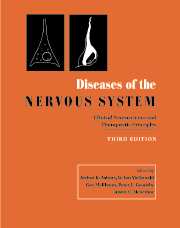Book contents
- Frontmatter
- Dedication
- Contents
- List of contributors
- Editor's preface
- PART I INTRODUCTION AND GENERAL PRINCIPLES
- PART II DISORDERS OF HIGHER FUNCTION
- PART III DISORDERS OF MOTOR CONTROL
- PART IV DISORDERS OF THE SPECIAL SENSES
- PART V DISORDERS OF SPINE AND SPINAL CORD
- PART VI DISORDERS OF BODY FUNCTION
- PART VII HEADACHE AND PAIN
- PART VIII NEUROMUSCULAR DISORDERS
- PART IX EPILEPSY
- 73 The cellular basis of epilepsy
- 74 The clinical spectrum of epilepsy
- 75 Status epilepticus
- 76 Assessment of the patient with epilepsy
- 77 Principles of pharmacotherapy of the epilepsies
- 78 Epilepsy surgery: disease treatment and investigative opportunity
- PART X CEREBROVASCULAR DISORDERS
- PART XI NEOPLASTIC DISORDERS
- PART XII AUTOIMMUNE DISORDERS
- PART XIII DISORDERS OF MYELIN
- PART XIV INFECTIONS
- PART XV TRAUMA AND TOXIC DISORDERS
- PART XVI DEGENERATIVE DISORDERS
- PART XVII NEUROLOGICAL MANIFESTATIONS OF SYSTEMIC CONDITIONS
- Complete two-volume index
- Plate Section
77 - Principles of pharmacotherapy of the epilepsies
from PART IX - EPILEPSY
Published online by Cambridge University Press: 05 August 2016
- Frontmatter
- Dedication
- Contents
- List of contributors
- Editor's preface
- PART I INTRODUCTION AND GENERAL PRINCIPLES
- PART II DISORDERS OF HIGHER FUNCTION
- PART III DISORDERS OF MOTOR CONTROL
- PART IV DISORDERS OF THE SPECIAL SENSES
- PART V DISORDERS OF SPINE AND SPINAL CORD
- PART VI DISORDERS OF BODY FUNCTION
- PART VII HEADACHE AND PAIN
- PART VIII NEUROMUSCULAR DISORDERS
- PART IX EPILEPSY
- 73 The cellular basis of epilepsy
- 74 The clinical spectrum of epilepsy
- 75 Status epilepticus
- 76 Assessment of the patient with epilepsy
- 77 Principles of pharmacotherapy of the epilepsies
- 78 Epilepsy surgery: disease treatment and investigative opportunity
- PART X CEREBROVASCULAR DISORDERS
- PART XI NEOPLASTIC DISORDERS
- PART XII AUTOIMMUNE DISORDERS
- PART XIII DISORDERS OF MYELIN
- PART XIV INFECTIONS
- PART XV TRAUMA AND TOXIC DISORDERS
- PART XVI DEGENERATIVE DISORDERS
- PART XVII NEUROLOGICAL MANIFESTATIONS OF SYSTEMIC CONDITIONS
- Complete two-volume index
- Plate Section
Summary
With a prevalence of 0.5 to 1% and over 50 million people affected worldwide, the epilepsies as a group represent the most common serious neurological disorder. In recent years, major advances have been made in characterizing their clinical and prognostic features and in clarifying their etiologies and pathophysiological mechanisms. Contrary to common belief, many epilepsies are potentially life threatening, with significant mortality being ascribed not only to the underlying disease but also to the seizures and their consequences (Nilsson et al., 1999). Moreover, seizures carry an important risk of morbidity, including traumatic injuries, psychiatric disturbances and impaired quality of life (Baker et al., 1997; Spitz, 1998). Even in educated societies, epilepsy is associated with significant stigma, and affected people may suffer more from prejudice and discrimination than from the actual manifestations of the disease (The Rest1 Group, 2000).
Fortunately, most epilepsy syndromes are fully treatable, and up to 70% of patients may achieve complete seizure control and live a normal life, mainly thanks to the availability of effective drugs. Appropriate management requires knowledge of the characteristics of the disease, its associated risks, its natural prognosis and, not least, the clinical pharmacology of antiepileptic drugs (AEDs). It is the purpose of this chapter to discuss the basic principles underlying rational drug selection and optimization of therapy.
Objectives of treatment
The treatment of epilepsy should fullfil at least two primary objectives.
Prevention of seizure recurrence
If exception is made for the control of ongoing seizures and status epilepticus, AEDs are prescribed to prevent seizure recurrence. The ultimate goal should be complete seizure control, but in severe epilepsies this may not be achievable, and a reduction in seizure frequency becomes a more realistic objective.
Minimization of side effects
Most AEDs have a narrow therapeutic index, i.e. the dosage required to achieve seizure control is close to that which produces significant toxicity. Skillful management rests with the ability to select the drug whose side effect profile is least likely to interfere with the patient's wellbeing, and to optimize its dosage to reduce the risk of side effects. Seizure control should not be achieved at any cost. Physicians should avoid the situation whereby patients are made to suffer more from the side effects of treatment than from the manifestations of the disease.
- Type
- Chapter
- Information
- Diseases of the Nervous SystemClinical Neuroscience and Therapeutic Principles, pp. 1301 - 1312Publisher: Cambridge University PressPrint publication year: 2002
- 3
- Cited by

